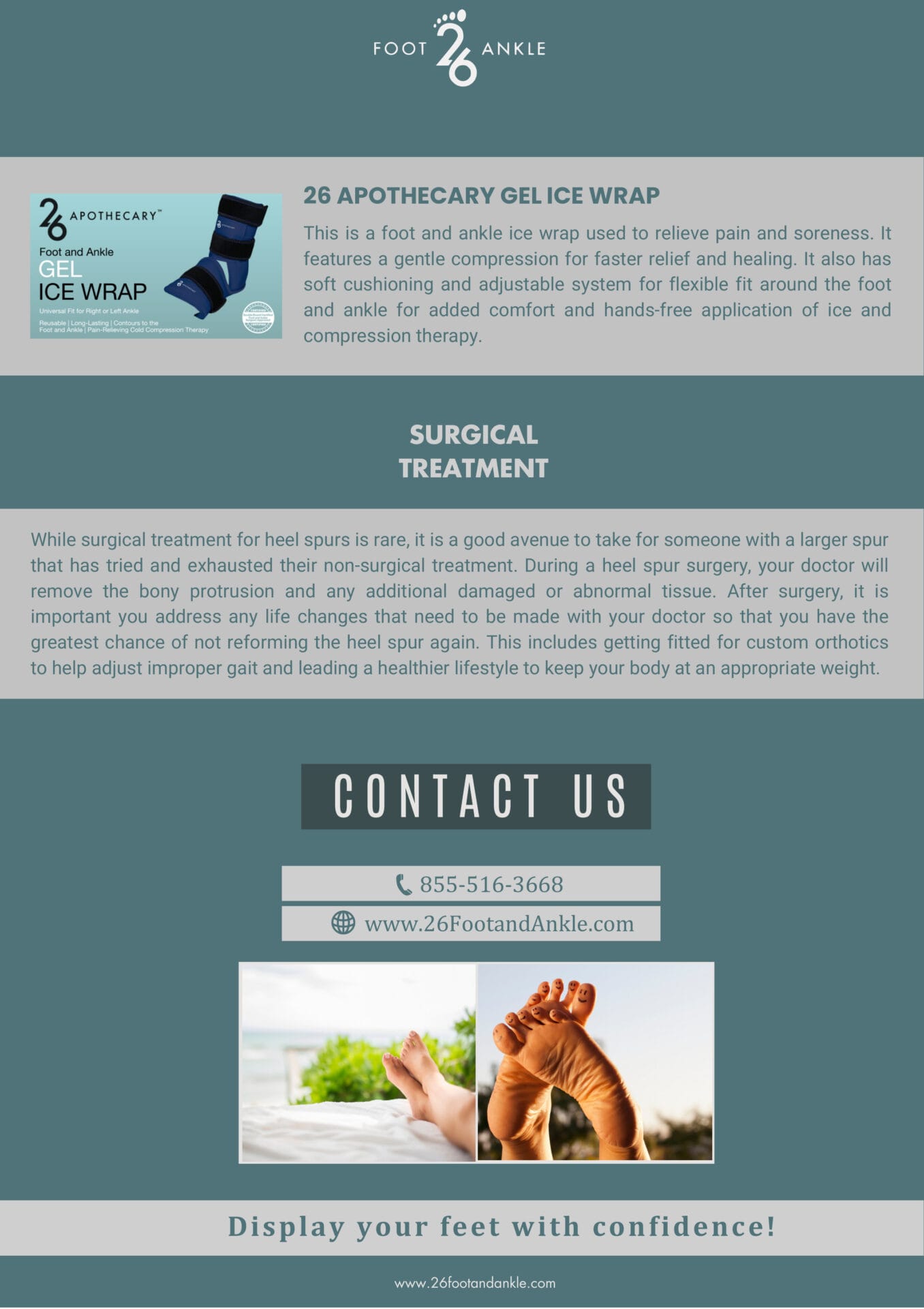The 26 Review
- What are Heel Spurs? a calcium deposit that causes a bony protrusion on the bottom or back of the heel bone
- Causes chronic stress on the heel bone, gait abnormalities, poorly fitting shoes,
- Symptoms sharp or stabbing pain, dull ache in the heel, swelling, bony protrusion on the heel
- Diagnosis physical examination, ultrasound, X-ray
- Treatment rest, ice, anti-inflammatory medication, orthotics, lifestyle/diet changes, surgery to remove the spur
Heel Pain: Heel Spurs E-Book


HEEL SPURS
Kick discomfort to the curb with our latest e-book, dedicated to tackling all the information you need to know about heel spurs. Walk tall and pain-free as you delve into proven strategies for relief and recovery. This comprehensive guide is your roadmap to putting back the spring in your step. Ready to conquer heel spurs? Download now and take the first confident stride towards lasting comfort!

Let’s take a closer look…
Heel spurs, or calcaneal spurs, are small protrusions of bone on the bottom and or back of the heel. These bony growths are commonly seen in individuals with either plantar fasciitis or Achilles tendinitis, which is inflammation of the plantar fascia ligament or Achilles Tendon that connects to the heel bone. While heel spurs do not always occur with plantar fasciitis or Achilles tendinitis, they typically occur together because both are caused by the same problem – chronic biomechanical imbalances in the foot.
Difference between Achilles tendinitis, plantar fasciitis, and heel spurs
Achilles Tendinitis is the condition that happens when the Achilles tendon that runs down the back of your leg is either torn or overstretched due to an overuse. If you have this condition, you will feel a sharp pain in the back of your heel throughout the day when walking. Read more here
Plantar Fasciitis is the condition that happens when the ligament that runs between the ball of your foot and your heel is either torn or overstretched due to overuse. If you have this condition, you may feel an intense stabbing in your heel and at the bottom of your foot throughout the day. This pain is especially common upon waking and first standing up in the morning. Read more here
Heel Spurs occur as a result to the inflammation and chronic tightness associated with plantar fasciitis or Achilles tendinitis. Overtime, your body reacts to your overused or overstretched fascia or tendon by creating extra bone. This calcified spur is known as a “bone spur”.
Therefore, it is important to address Achilles Tendinitis or plantar fasciitis as soon as possible in order to properly care for your feet. In doing so, this prevents your body from overcompensating for faulty mechanics and creating additional bone and potentially more severe problems.
Causes
There are many causes of heel spurs, but the most common is a consistent overuse or an overstretch of the Achilles tendon in the back of the foot or in the plantar fascia at the bottom of the foot. This can be from activities such as running, jumping, or even walking. Gait disorders are a major contributor to heel spurs and can be easily addressed with improved shoe gear and custom orthotics. Other causes include arthritis, being overweight, having tight calf muscles, or wearing shoes that don’t fit properly. Heel spurs can also be caused by an injury or trauma to the heel bone. In some individuals, bone spurs are hereditary and can involve additional bones throughout the body.
Symptoms
The most common symptom of heel spurs is a stabbing pain in the heel of the foot. This pain can be mild or severe. It is usually worse when you walk, running, or stand on your toes and is especially worse in the morning upon waking up and getting out of bed. You may also have pain when you stretch your calf muscles. The pain may go away for a while after you rest, but if you recognize it consistently returning, you may be dealing with heel spurs. Lastly, heel spurs on the bottom of the foot cannot be seen or felt as they are deep inside your foot, however, heel spurs on the back of the foot can be very prominent and felt to the touch.
Diagnosis
Your doctor will do a physical examination of your feet and ask about your health history and any other factors that could be contributing to your experiencing or development of heel spurs. This would include any recent injuries, health history, weight gain, recent stress level, and physical activity. Ultimately X-rays are almost always required to diagnose heel spurs as this is the clearest and most definitive way to diagnose a bony protrusion. Ultrasound can also be used to visualize a bone spur.
Treatment: Non-Surgical
There are several options available for treating heel spurs. Some of these include rest, ice, over-the-counter pain medication, stretching exercises, physical therapy, braces, and orthotic devices. Rest and ice are often the first line of treatment. If non-surgical options fail to reduce your inflammation and pain and you find that you have a more severe bone spur, surgery may be recommended to you by your doctor.
Treatment: Surgical
While surgical treatment for heel spurs is rare, it is a good avenue to take for someone with a larger spur that has tried and exhausted their non-surgical treatment. During a heel spur surgery your doctor will remove the bony protrusion and any additional damaged or abnormal tissue. After surgery it is important you address any life changes that need to be made with your doctor so that you have the greatest chance of not reforming the heel spur again. This includes getting fitted for custom orthotics to help adjust improper gait and leading a healthier lifestyle to keep your body at an appropriate weight.